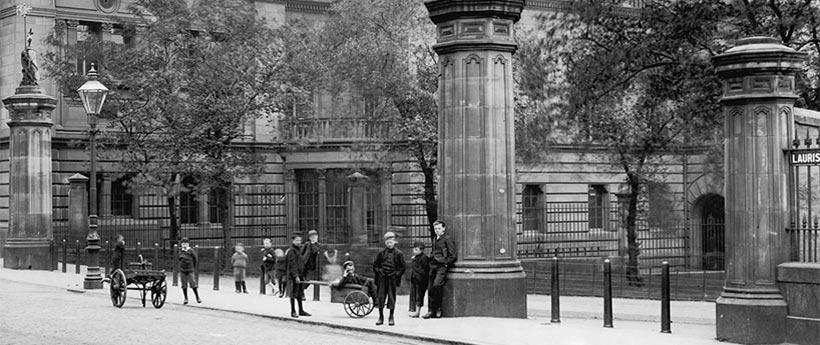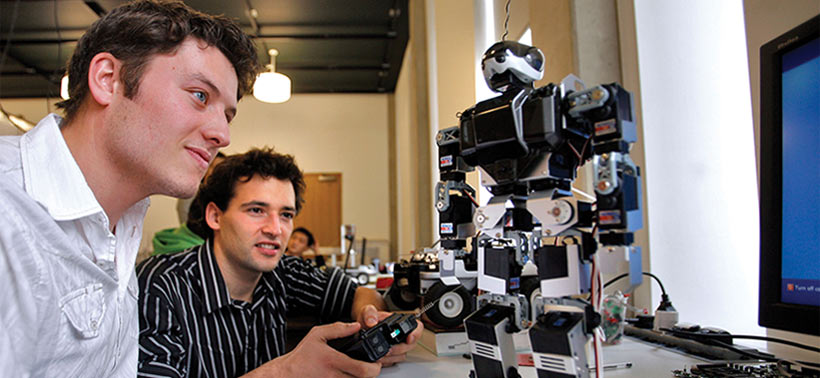Learning for life Having recently been ranked as one of the world's top 20 universities, we take a look at the University of Edinburgh and some of the things that make it a world-class educational institution.
It's an establishment that has encouraged some of the world's greatest minds to reach their potential. It ranks as the 17th best university in the world and one of its Professors was recently awarded a Nobel Prize. We are, of course, talking about the outstanding, venerable educational institution that is the University of Edinburgh.
Reputation
An instantly recognisable institution for education, there's no denying that the University of Edinburgh's reputation is world-class. The University has received countless accolades, been associated with three prime-ministers and has recently received its highest ranking yet when it came in as the 17th best university in the world in the QS World University Rankings. The University's commitment to research and the strength of its graduates were amongst the many reasons why Edinburgh was bestowed such an accolade. The University of Edinburgh's Principal Professor Sir Timothy O'Shea, commented: “The news about our research funding figures and our continued rise in the various world league tables reflects the quality, hard-work and dedication of our staff and students as well as the highly strategic support we receive from the Scottish Government.
"With such support, the University can go on producing world-leading research, which has the potential to change people's lives for the better."

Professor Peter Higgs CH
Nobel Prize Winners
The University of Edinburgh is associated with 16 Nobel Prize Winners, including Alexander Fleming, Edward Victor Appleton, and of course, the most recent addition to that list, Professor Peter Higgs CH.
The Emeritus Professor of Theoretical Physics was jointly awarded the Nobel Prize earlier this year in recognition of his outstanding contribution to the theoretical work that led to the prediction of the Higgs boson particle.
Professor Higgs suggested the existence of such a particle in 1964 when he was a young lecturer at the University. The existence of the particle was recently confirmed by Scientists at the European Organisation for Nuclear Research (CERN). The Higgs boson particle, which enables other fundamental particles to acquire their mass, represents a major step in our understanding of the physical universe.
Professor Higgs commented on being awarded the Nobel Prize: "I am overwhelmed to receive this award and thank the Royal Swedish Academy. I would also like to congratulate all of those who have contributed to the discovery of this new particle and thank my family, friends and colleagues for their support. I hope this recognition of fundamental science will help raise awareness of the value of blue-sky research."

History
The University of Edinburgh started life as a College of Law before broadening its opportunities for learning and becoming a University in 1583. At that time, it was one of only six universities in the UK and despite Scotland's size, it was home to four out of the six higher-education facilities.
Prior to the early 19th Century, the University didn't have a specific campus until Old College was built on South Bridge. Now better known as the University's School of Law, this building was where the University of Edinburgh established its expertise in the areas of anatomy and medicine – the body of the infamous William Burke was sent here for dissection in one of its anatomy theatres after he had been hanged.
As the University's reputation in the medical arena continued to grow, word spread across land and sea, and from the late 18th to the early 19th century it was considered the best medical school in the English-speaking world. As a result, demand for places at the University's medical school couldn't keep up with the number of students looking to enrol. And so New College, situated on the Mound in Edinburgh, became the new home of teaching medicine in Edinburgh.
Since the 19th century, the University of Edinburgh has gone from using a faculty-based education model, to teaching in three colleges: the College of Humanities & Social Science, the College of Science & Engineering and the College of Medicine & Veterinary Medicine.
Notable graduates from the University of Edinburgh
Some of the greatest talents of our time graduated from the University of Edinburgh. Names such as those noted below are what help to cement this University as world-class:
- Charles Darwin
- James Clerk Maxwell
- David Hume
- Alexander Graham Bell
- Sir Arthur Conan Doyle
- Sir Walter Scott
- Gordon Brown
- Peter Higgs
- Robert Adam
- JK Rowling
- Sir Chris Hoy
- Eric Liddell
- J.M.Barrie
- Stella Rimington

Tradition
The University of Edinburgh has a number of traditions, but none more traditional than that of graduation day.
For the most part, the graduation ceremony at the University of Edinburgh is a familiar occasion; students are clothed in the appropriate gown and when their name is called, they collect their scroll. But at Edinburgh, when a student goes to collect their scroll from the Vice Chancellor, they are tapped on the head with a sacred cap, the Geneva Bonnet to be precise. According to University legend, this hat is made from cloth taken from the breeches of John Knox.
The hat gained further significance in 2006 when Astronaut and University of Edinburgh alumnus, Dr Piers Sellers, returned to the University one of its crests that he had previously taken into space. This was then stitched into the Geneva Bonnet.

The University of Edinburgh today
In the 2012-2013 academic year, the University of Edinburgh had just under 33,000 students. With a thirst for research and for developing the best the world can offer in terms of talent, the future for this Institution is looking brighter than ever.







